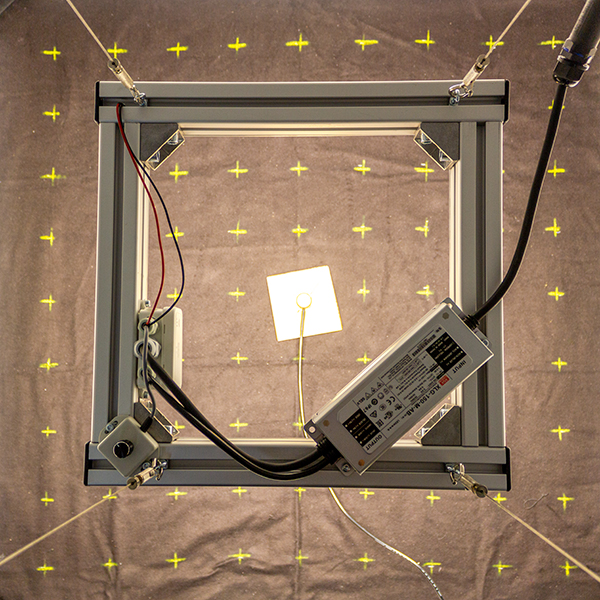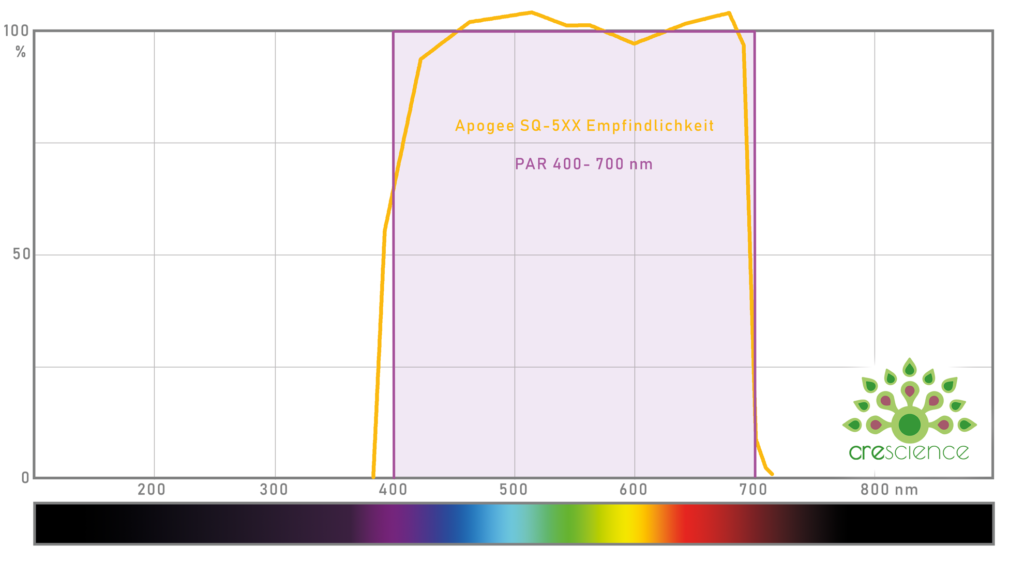Crescience PAR database
We put our LED products through their paces under real conditions. The measurements take place in a closed test environment. In contrast to tests in an integrating sphere, the results are therefore subject to losses that are also present in a normal installation environment. For example, reflection losses on the walls and the power loss of the power supply.
Overview: Crescience LEDs in PAR test
FLUXshield Gold
| Area | Distance | PPFD Map | Driver | Average PPFD | Homogeneity (Min. / Max.) | PPFD / Performance | Test Meta |
|---|---|---|---|---|---|---|---|
| 60 x 60 cm | 60 cm | HLG-150H-54B | 641 µmol/m² | 67,10% | 1,49 µmol/m²/J | Power consumption (socket) 155 W, Board Temp. 34°C, Ambient Temp. 23°C | |
| 60 x 60 cm | 40 cm | HLG-150H-54B | 804 µmol/m² | 70,50% | 1,87 µmol/m²/J | Power consumption (socket) 155 W, Board Temp. 36°C, Ambient Temp. 25°C | |
| 60 x 60 cm | 30 cm | HLG-150H-54B | 908 µmol/m² | 63,80% | 2.11 µmol/m²/J | Power consumption (socket) 155 W, Board Temp. 35°C, Ambient Temp. 24°C | |
| 60 x 60 cm | 20 cm | HLG-150H-54B | 1036 µmol/m² | 53,20% | 2,41 µmol/m²/J | Power consumption (socket) 155 W, Board Temp. 35°C, Ambient Temp. 24°C | |
| 60 x 60 cm | 40 cm | XLG-240-H-AB | 1169 µmol/m² | 70,70% | 1,75 µmol/m²/J | Power consumption (socket) 240 W, Board Temp. 45°C, Ambient Temp. 25°C | |
| 60 x 60 cm | 30 cm | XLG-240-H-AB | 1315 µmol/m² | 61,90% | 1,97 µmol/m²/J | Power consumption (socket) 240 W, Board Temp. 45°C, Ambient Temp. 25°C | |
| 60 x 60 cm | 20 cm | XLG-240-H-AB | 1511 µmol/m² | 50,80% | 2,27 µmol/m²/J | Power consumption (socket) 240 W, Board Temp. 45°C, Ambient Temp. 25°C | |
| 80 x 80 cm | 60 cm | XLG-240-H-AB | 624 µmol/m² | 65,30% | 1,64 µmol/m²/J | Power consumption (socket) 244 W, Board Temp. 40°C, Ambient Temp. 21°C | |
| 80 x 80 cm | 40 cm | XLG-240-H-AB | 746 µmol/m² | 46,80% | 1,98 µmol/m²/J | Power consumption (socket) 241 W, Board Temp. 43°C, Ambient Temp. 24°C | |
| 80 x 80 cm | 30 cm | XLG-240-H-AB | 827 µmol/m² | 31,60% | 2,20 µmol/m²/J | Power consumption (socket) 241 W, Board Temp. 43°C, Ambient Temp. 24°C | |
| 80 x 80 cm | 20 cm | XLG-240-H-AB | 922 µmol/m² | 18,30% | 2,45 µmol/m²/J | Power consumption (socket) 241 W, Board Temp. 43°C, Ambient Temp. 24°C |
FLUXshield Silver
| Area | Distance | PPFD Map | Driver | Average PPFD | Homogeneity (Min. / Max.) | PPFD / Performance | Test Meta |
|---|---|---|---|---|---|---|---|
| 60 x 60 cm | 60 cm | XLG-100-H-AB | 443 µmol/m² | 76,20% | 1,52 µmol/m²/J | Power consumption (socket) 105 W, Board Temp. 41°C, Ambient Temp. 23°C | |
| 60 x 60 cm | 40 cm | XLG-100-H-AB | 562 µmol/m² | 60,00% | 1,93 µmol/m²/J | Power consumption (socket) 105 W, Board Temp. 41°C, Ambient Temp. 23°C | |
| 60 x 60 cm | 30 cm | XLG-100-H-AB | 647 µmol/m² | 43,50% | 2.24 µmol/m²/J | Power consumption (socket) 104 W, Board Temp. 41°C, Ambient Temp. 23°C | |
| 60 x 60 cm | 20 cm | XLG-100-H-AB | 759 µmol/m² | 26,10% | 2,60 µmol/m²/J | Power consumption (socket) 105 W, Board Temp. 41°C, Ambient Temp. 23°C |
The Slim Square - FLUXstrip x4 (cSpec Enhanced)
| Area | Distance | PPFD Map | Driver | Average PPFD | Homogeneity (Min. / Max.) | PPFD / Performance | Test Meta |
|---|---|---|---|---|---|---|---|
| 60 x 60 cm | 40 cm | XLG-150-M-AB | 818 µmol/m² | 70,30% | 1.89 µmol/m²/J | Power consumption (socket) 156 W, Board Temp. 50°C, Ambient Temp. 26°C | |
| 60 x 60 cm | 30 cm | XLG-150-M-AB | 923 µmol/m² | 63,60% | 2,13 µmol/m²/J | Power consumption (socket) 156 W, Board Temp. 50°C, Ambient Temp. 26°C | |
| 60 x 60 cm | 25 cm | XLG-150-M-AB | 991 µmol/m² | 58,60% | 2.29 µmol/m²/J | Power consumption (socket) 156 W, Board Temp. 50°C, Ambient Temp. 26°C | |
| 60 x 60 cm | 20 cm | XLG-150-M-AB | 1063 µmol/m² | 51,90% | 2,41 µmol/m²/J | Power consumption (socket) 156 W, Board Temp. 50°C, Ambient Temp. 25°C | |
| 60 x 60 cm | 40 cm | XLG-150-M-AB | 834 µmol/m² | 71,10% | 1.92 µmol/m²/J | With reflectors, power consumption (socket) 156 W, Board Temp. 47°C, Ambient Temp. 26°C | |
| 60 x 60 cm | 30 cm | XLG-150-M-AB | 946 µmol/m² | 62,80% | 2.18 µmol/m²/J | With reflectors, power consumption (socket) 156 W, Board Temp. 47°C, Ambient Temp. 26°C | |
| 60 x 60 cm | 25 cm | XLG-150-M-AB | 1004 µmol/m² | 57,80% | 2.32 µmol/m²/J | With reflectors, power consumption (socket) 156 W, Board Temp. 47°C, Ambient Temp. 26°C | |
| 60 x 60 cm | 20 cm | XLG-150-M-AB | 1073 µmol/m² | 51,00% | 2,48 µmol/m²/J | With reflectors, power consumption (socket) 156 W, Board Temp. 47°C, Ambient Temp. 26°C |
The Estate - FLUXengine x4
| Area | Distance | PPFD Map | Driver | Average PPFD | Homogeneity (Min. / Max.) | PPFD / Performance | Test Meta |
|---|---|---|---|---|---|---|---|
| 60 x 60 cm | 30 cm | XLG-150-M-AB | 875 µmol/m² | 64,30% | 2.10 µmol/m²/J | Power consumption (socket) 150 W, Board Temp. 49°C, Ambient Temp. 23°C | |
| 60 x 60 cm | 25 cm | XLG-150-M-AB | 936 µmol/m² | 57,10% | 2.25 µmol/m²/J | Power consumption (socket) 150 W, Board Temp. 49°C, Ambient Temp. 23°C | |
| 60 x 60 cm | 20 cm | XLG-150-M-AB | 1013 µmol/m² | 49,10% | 2.42 µmol/m²/J | Power consumption (socket) 150 W, Board Temp. 49°C, Ambient Temp. 23°C |
The Wingman Mk II - FLUXshield Silver x2
| Area | Distance | PPFD Map | Driver | Average PPFD | Homogeneity (Min. / Max.) | PPFD / Performance | Test Meta |
|---|---|---|---|---|---|---|---|
| 120 x 60 cm | 60 cm | XLG-240-H-AB | 525 µmol/m² | 77,80% | 1.67 µmol/m²/J | Power consumption (socket) 223 W, Board Temp. 50°C, Ambient Temp. 30°C | |
| 120 x 60 cm | 40 cm | XLG-240-H-AB | 624 µmol/m² | 65,1% | 1,98 µmol/m²/J | Power consumption (socket) 223 W, Board Temp. 50°C, Ambient Temp. 30°C | |
| 120 x 60 cm | 30 cm | XLG-240-H-AB | 694 µmol/m² | 44,50% | 2,20 µmol/m²/J | Power consumption (socket) 223 W, Board Temp. 50°C, Ambient Temp. 31°C | |
| 120 x 60 cm | 20 cm | XLG-240-H-AB | 779 µmol/m² | 23,30% | 2.47 µmol/m²/J | Power consumption (socket) 223 W, Board Temp. 51°C, Ambient Temp. 31°C |
The Wingcommander - FLUXshield Silver x3
| Area | Distance | PPFD Map | Driver | Average PPFD | Homogeneity (Min. / Max.) | PPFD / Performance | Test Meta |
|---|---|---|---|---|---|---|---|
| 120 x 60 cm | 60 cm | ELGC-300-L-AB | 820 µmol/m² | 63,90% | 1,87 µmol/m²/J | Power consumption (socket) 316 W, Board Temp. 48°C, Ambient Temp. 28°C | |
| 120 x 60 cm | 40 cm | ELGC-300-L-AB | 987 µmol/m² | 47,40% | 2.25 µmol/m²/J | Power consumption (socket) 316 W, Board Temp. 48°C, Ambient Temp. 28°C | |
| 120 x 60 cm | 30 cm | ELGC-300-L-AB | 1091 µmol/m² | 36,10% | 2.49 µmol/m²/J | Power consumption (socket) 316 W, Board Temp. 48°C, Ambient Temp. 28°C | |
| 120 x 60 cm | 20 cm | ELGC-300-L-AB | 1213 µmol/m² | 20,60% | 2.76 µmol/m²/J | Power consumption (socket) 316 W, Board Temp. 47°C, Ambient Temp. 27°C |
The Frugal Four - FLUXshield Silver x4
| Area | Distance | PPFD Map | Driver | Average PPFD | Homogeneity (Min. / Max.) | PPFD / Performance | Test Meta |
|---|---|---|---|---|---|---|---|
| 120 x 120 cm | 60 cm | HLG-480H-C2100B | 598 µmol/m² | 79,60% | 1.96 µmol/m²/J | Power consumption (socket) 454 W, Board Temp. 50°C, Ambient Temp. 30°C | |
| 120 x 120 cm | 40 cm | HLG-480H-C2100B | 667 µmol/m² | 62,60% | 2.21 µmol/m²/J | Power consumption (socket) 449 W, Board Temp. 51°C, Ambient Temp. 32°C | |
| 120 x 120 cm | 30 cm | HLG-480H-C2100B | 710 µmol/m² | 41,10% | 2.35 µmol/m²/J | Power consumption (socket) 450 W, Board Temp. 50°C, Ambient Temp. 30°C | |
| 120 x 120 cm | 20 cm | HLG-480H-C2100B | 773 µmol/m² | 16,70% | 2.53 µmol/m²/J | Power consumption (socket) 455 W, Board Temp. 49°C, Ambient Temp. 28°C |
The Generous Four - FLUXshield Gold x4
| Area | Distance | PPFD Map | Driver | Average PPFD | Homogeneity (Min. / Max.) | PPFD / Performance | Test Meta |
|---|---|---|---|---|---|---|---|
| 120 x 120 cm | 60 cm | HLG-480H-C2100B | 620 µmol/m² | 60,90% | 2.03 µmol/m²/J | Power consumption (socket) 439 W, Board Temp. 39°C, Ambient Temp. 29°C | |
| 120 x 120 cm | 40 cm | HLG-480H-C2100B | 699 µmol/m² | 50,40% | 2.29 µmol/m²/J | Power consumption (socket) 439 W, Board Temp. 41°C, Ambient Temp. 32°C | |
| 120 x 120 cm | 30 cm | HLG-480H-C2100B | 743 µmol/m² | 42,60% | 2.44 µmol/m²/J | Power consumption (socket) 439 W, Board Temp. 41°C, Ambient Temp. 31°C | |
| 120 x 120 cm | 20 cm | HLG-480H-C2100B | 774 µmol/m² | 30,40% | 2.53 µmol/m²/J | Power consumption (socket) 440 W, Board Temp. 40°C, Ambient Temp. 30°C | |
| 120 x 120 cm | 15 cm | HLG-480H-C2100B | 820 µmol/m² | 22,20% | 2.68 µmol/m²/J | Power consumption (socket) 440 W, Board Temp. 39°C, Ambient Temp. 30°C |
The Halo - FLUXengine x4
| Area | Distance | PPFD Map | Driver | Average PPFD | Homogeneity (Min. / Max.) | PPFD / Performance | Test Meta |
|---|---|---|---|---|---|---|---|
| 60 x 60 cm | 60 cm | XLG-150-M-AB | 637 µmol/m² | 77,80% | 1,48 µmol/m²/J | Power consumption (socket) 155 W, Board Temp. 52°C, Ambient Temp. 25°C | |
| 60 x 60 cm | 40 cm | XLG-150-M-AB | 803 µmol/m² | 67,80% | 1,87 µmol/m²/J | Power consumption (socket) 155 W, Board Temp. 52°C, Ambient Temp. 25°C | |
| 60 x 60 cm | 30 cm | XLG-150-M-AB | 910 µmol/m² | 57,50% | 2.11 µmol/m²/J | Power consumption (socket) 155 W, Board Temp. 52°C, Ambient Temp. 25°C | |
| 60 x 60 cm | 20 cm | XLG-150-M-AB | 1053 µmol/m² | 42,30% | 2,45 µmol/m²/J | Power consumption (socket) 155 W, Board Temp. 52°C, Ambient Temp. 25°C | |
| 60 x 60 cm | 40 cm | XLG-150-M-AB | 793.9 µmol/m² | 68,10% | 1,83 µmol/m²/J | 45° rotated, power consumption (socket) 156 W, Board Temp. 51°C, Ambient Temp. 24°C | |
| 60 x 60 cm | 30 cm | XLG-150-M-AB | 921 µmol/m² | 57,50% | 2,13 µmol/m²/J | 45° rotated, power consumption (socket) 156 W, Board Temp. 47°C, Ambient Temp. 22°C | |
| 60 x 60 cm | 20 cm | XLG-150-M-AB | 1085 µmol/m² | 44,70% | 2,46 µmol/m²/J | 45° rotated, power consumption (socket) 159 W, Board Temp. 45°C, Ambient Temp. 20°C |
The Triple Bar - FLUXengine x6
| Area | Distance | PPFD Map | Driver | Average PPFD | Homogeneity (Min. / Max.) | PPFD / Performance | Test Meta |
|---|---|---|---|---|---|---|---|
| 80 x 80 cm | 60 cm | XLG-240-M-AB | 675 µmol/m² | 69,7% | 1,70 µmol/m²/J | Power consumption (socket) 254 W, Board Temp. 53°C, Ambient Temp. 24°C | |
| 80 x 80 cm | 40 cm | XLG-240-M-AB | 800 µmol/m² | 57,70% | 2,02 µmol/m²/J | Power consumption (socket) 254 W, Board Temp. 54°C, Ambient Temp. 25°C | |
| 80 x 80 cm | 30 cm | XLG-240-M-AB | 887 µmol/m² | 46,30% | 2.24 µmol/m²/J | Power consumption (socket) 254 W, Board Temp. 54°C, Ambient Temp. 25°C | |
| 80 x 80 cm | 20 cm | XLG-240-M-AB | 985 µmol/m² | 31,20% | 2,48 µmol/m²/J | Power consumption (socket) 254 W, Board Temp. 54°C, Ambient Temp. 25°C |
The database is currently under construction. In the future more variations and kits will be added. If you would like to get a comparison value for your lamp, you can Contact and have them tested by us.

Why measure PPFD?
The most important factor when designing a LED system for horticulture is the performance of the fixture.
There are two approaches to this: Laboratory tests that integrate the photon output. These have the advantage of a high degree of standardization and thus enable a very objective comparison of different plant lamps. However, a high measured photon output in a Integrating sphere not necessarily that this luminosity is actually available for the plants in the area under cultivation. The indicated PPF values are therefore of a more theoretical nature.
We therefore perform standardized field tests and measure the photosynthetic photon flux density (PPFD) in a measurement grid. In this way we make visible how much light (PAR) actually reaches the plants and, above all, how the intensity is distributed.
The ultimate goal is not to whitewash - with our PAR test system we deliver minimum values which the user can exceed with a high probability in reality. Our test standards are transparent!
Test standard for PPFD measurements
Automated setup for PAR measurement. White coated HDF boards on walls and top, floor matt black.
The test setup currently allows measurements on surfaces with side lengths of 60, 80, 120 and 150 cm.
The effective usable radiation of a plant lamp depends strongly on the distance. We therefore measure different distances in order to the ideal hanging height to determine.
Unless otherwise specified, the lamp is placed centrally above the surface.
The power consumption is measured at the socket (input power of the driver). Electrical losses are therefore already taken into account. If possible, color channels outside the PAR range are switched off (concerns far red/infrared and UV radiation).
Old test series
PAR tests in a Homebox Ambient Q100 with manual measurement in 10 cm increments. Black floor, white walls.
| Designation | Area | Height | Input power (socket) | Average PPFD | PPFD/performance [µmol/m²/J] | Homogeneity (min./max.) | Distribution (Map) | Driver |
|---|---|---|---|---|---|---|---|---|
| The Halo - FLUXengine x4 | 100 x 100 cm | 40 cm | 153 W | 329 µmol/m²s | 2.15 µmol/m²/J | 17% | XLG-150-M-AB | |
| The Triple Bar - FLUXengine x6 | 100 x 100 cm | 40 cm | 265 W | 560 µmol/m²s | 2.11 µmol/m²/J | 24% | XLG-240-M-AB | |
| FLUXengine x8 (old reference - LM301B) | 100 x 100 cm | 40 cm | 355 W | 632 µmol/m²s | 1.78 µmol/m²/J | 55% | 2x HLG-320H-C2800 | |
| FLUXengine x8 (old reference - LM301B) | 100 x 100 cm | 40 cm | 473 W | 821 µmol/m²s | 1.74 µmol/m²/J | 55% | 2x HLG-320H-C2800 | |
| FLUXshield Pro | 100 x 100 cm | 40 cm | 153 W | 289 µmol/m²s | 1.88 µmol/m²/J | 17% | XLG-150-H-AB | |
| FLUXshield Pro Red | 100 x 100 cm | 40 cm | 153 W | 316 µmol/m²s | 2.06 µmol/m²/J | 18% | XLG-150-H-AB | |
| LXC Dual FLUXshield Pro | 100 x 100 cm | 40 cm | 308 W | 584 µmol/m²s | 1.89 µmol/m²/J | 21% | 2x XLG-150-H-AB | |
| LXC Dual FLUXshield Pro Red | 100 x 100 cm | 40 cm | 308 W | 621 µmol/m²s | 2.01 µmol/m²/J | 21% | 2x XLG-150-H-AB | |
28 cm strip Samsung 660nm (6x LH351H) | 100 x 100 cm | 40 cm | 12.5 W | 23 µmol/m²s | 1.85 µmol/m²/J | 11% | - | LCM-25 (700 mA) |
APEXengine 660M (Mk II) | 100 x 100 cm | 40 cm | 11.5 W | 27 µmol/m²s | 2.38 µmol/m²/J | 11% | - | LCM-25 (1050 mA) |


